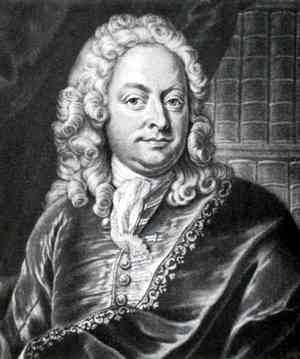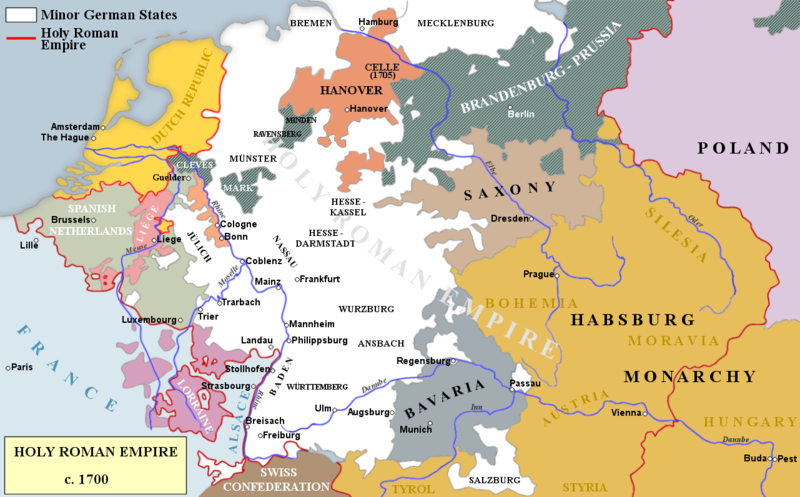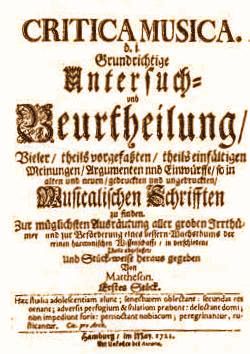


Johann Mattheson 1746
Engraving by Johann Jacob Haid
Source: Academic

Johann Mattheson's Germany circa 1700
The Holy Roman Empire is decided by Electors sanctioned by the Pope
Hamburg to the north is just south of Denmark not quite on the map
Source:
Wikipeida
Born on 28 September 1681 in Hamburg, Johann Mattheson was a multi-faceted talent whose father was a tax collector. Albeit a strong composer he more concentrated on literature and is generally known as the original music critic, a field which his younger contemporary by about thirty years in France, Jean-Jacques Rousseau, would also explore a generation later. Mattheson was a vocalist who started to appear in female opera roles in 1696, turning to tenor as his voice changed. He would become, however, the first major composer to defy Church custom and install women in choirs rather than boys or castrati [Cambridge / ProQuest].
Mattheson completed his initial opera, a singspiel titled 'Die Plejades oder Das Siebengestirne', in 1699. He isn't known to have composed specifically for piano, but he was about age nineteen when Bartolomeo Cristofori invented the first in Florence in 1700. A quarter century later an article by Mattheson in his periodical, 'Musica Critica', probably provoked Gottfried Silbermann's improvements to the new instrument which would eventually find it replacing the harpsichord. Mattheson published 24 issues of 'Musica Critica' from 1722 to 1725.
In 1703 Mattheson received George Handel who came visiting Hamburg from Halle and took his junior by three years under wing. The next year found them fighting a duel, supposedly, as Mattheson denied it, supposedly. It seems probable that something like this did occur, but accounts vary widely. The story goes that the two exploded into argument during the premiere of Mattheson's opera, 'Die unglückselige Cleopatra', in which Mattheson played the part of Marc Antony. The intended conductor at harpsichord was one Reinhard Keiser who was apparently too drunk to finish the performance. Handel who was at second violin took his place. It was likely intended that Mattheson replace Keiser once Antony's role ended (dying in the drama), but Handel commandeered the scene, insisting his proper place to be at harpsichord conducting. In a passion Mattheson challenged Handel to a duel and the pair made their way outside. Despite the version that has Handel never raising his weapon it's said that Mattheson drove his sword directly to Handel's heart, the latter saved by a button if not a thick bundle of scores. Whatever the truth of this dispute, Mattheson starred as the orphan, Fernando, in Handel's initial opera, 'Almira', on 8 January 1705 and they remained in correspondence throughout the years. Though Mattheson wrote multiple operas his last, 'Die geheimen Begebenheiten Henrico IV', arrived in 1711 only halfway into his life.
'Mein Leben ist hin' ('My Life is gone') Aria (song) by Johann Mattheson
From the opera 'Die unglückselige Cleopatra' ('The unfortunate Cleopatra')
Premiere in Hamburg 20 Aug 1704 Libretto: Friedrich-Christian Feustking
Tafelmusik Baroque Orchestra Soprano: Isabel Bayrakdarian
Mattheson published his Op 1 in 1708 titled 'XII Sonates à 2-3 flutes sans basse', followed by 'Six Cantatas' Op 2 perhaps the same year. Those are the only two works of which I know in Mattheson's oeuvre that are given Opus numbers. Matheson is credited with 88 books consisting of music, music theory, biographies and other treatises. He published the satire, 'Das neueröffnete Orchestre' ('The Newly Opened Orchestra'), in 1713. Among works to follow were his 'Suite No.11 in C major' no later than 1714 and 'Harmonisches Denckmahl' ('Harmonious Memorial'), a collection of twelve suites for harpsichord in 1714.
'Saraband' No.5 of 'Suite No.11 in C major' Saraband by Johann Mattheson
Published < 1714
Harpsichord: René Sanhueza Gaete
'12 Suites' aka 'Harmonisches Denckmahl' Saraband by Johann Mattheson
Published 1714
Harpsichord: Julien Monette
It was 1715 when Mattheson's first of numerous oratorios arrived to Hamburg, 'Die heilsame Geburt und Menschwerdung unsers Herrn und Heilandes Jesu Christi'. It was also 1715 when he succeeded Friedrich Nicolaus Bruhns in practice as organist and musical director of St. Mary's Cathedral in Hamburg, though Bruhns formally held that position until his death in 1718. Mattheson published 'Der Brauchbare Virtuoso' ('The Useful Virtuoso') in 1720, a set of 12 sonatas for flute or violin with continuo [RISM].
'Die heilsame Geburt und Menschwerdung unsers Herrn und Heilandes Jesu Christi'
'The salutary Birth and Incarnation of our Lord and Savior Jesus Christ'
Oratorio Christmas magnificat by Johann Mattheson
Premiere in Hamburg 1715
Kölner Akademie / Michael Alexander Willens
This album: jpc Johan van Veen
'Sonata No.2 in G major' from 'Der Brauchbare Virtuoso' ('The Useful Virtuoso') Johann Mattheson
Sonata for flute or violin w continuo
Published 1720
Trio Corelli:
Violin: Elisabeth Schneider Archlute: Viggo Mangor Organ: Ulrik Spang-Hanssen
This album: All Music
Per above, Mattheson is dubbed the original music critic due to his periodical, 'Musica Critica', which he published from 1722-1725 [digital copy]. In 1723 his oratorio, 'Das Lied des Lammes' ('The Song of the Lamb'), arrived, a Passion setting with paraphrasing from 'John' by Christian Heinrich Postel [text].

Musica Critica 1722-1725
Periodical of "Musical Writings"
Source: Wikimedia Commons
'Schlafe wohl nach deinem Leiden' ('Sleep well after your Suffering')
Oratorio Passion setting from 'John' by Johann Mattheson
Final chorus from 'Das Lied des Lammes' Paraphrase: Christian Heinrich Postel
Premiere in Hamburg 1723
Baritone: Matthew Leese Bloomington Early Music Festival
In a 1725 issue of 'Musica Critica' Mattheson included a translation of Scipione Maffei's 1711 description of Bartolomeo Christofori's new hammer action instrument which he called a pianoforte (cembalo col pian' e forte) in 'Giornale dei letterati d’Italia'. Invented in 1700, Cristofori or his apprentice, Giovanni Ferrini, was able to sell five of his newly developed pianos to Queen Maria Barbara de Braganza of Spain who had become a lifelong pupil of Domenico Scarlatti about 1720 before becoming queen by marriage to Ferdinand VI in 1729. Scarlatti is thought to be the first major composer to write specifically for piano (his queen owning some), though Lodovico Giustini precedes him as of his 1732 'Sonate da cimbalo di piano e forte' Op 1. In northern Europe, however, Cristofori's Florentine piano wasn't received well. J.S. Bach disliked it due that it was too heavy to his touch and too soft on treble. Though he found Gottfried Silbermann's improvements promising enough to promote (testing the instrument at the court of Frederick the Great, King of Prussia), he continued composing for harpsichord. All to say that since Silbermann likely read Mattheson's translation of Maffei's critique of Cristofori's instrument it was a likely catalyst to the development of the piano such that it was well along its way to replacing the harpsichord by 1800. This publication was probably the most affecting and long-lasting contribution to music that Mattheson made, mentioning an already old invention nigh en passant, igniting Silbermann's inflation to Cristofori's spark toward the grand instrument of the ages at the heart of music as we've known it ever since.
Mattheson left his position at St. Mary's in 1728 due to increasing deafness. Fluent in English, he then served as a diplomat, often sailing abroad. His works in his latter career were chiefly literary. Like other composers Mattheson was buried in a church, St. Michael's in Hamburg, upon his death on 17 April 1764. He had premiered his oratorio, 'Das fröhliche Sterbelied' ('The Happy Dying Song'), with text by Johann Georg Glauche in Hamburg in 1760. This was performed with direction by Georg Telemann at his funeral on 25 April 1764.
Sources & References for Johann Mattheson:
Aryeh Oron (Bach Cantatas)
Ravi Staff (All Music)
VF History (notes)
Audio of Mattheson: Classical Archives
Compositions / Publications:
Fred Gary (publications)
IMSLP (publications / digital copies)
Internet Archive (publications / digital copies)
Klassika (compositions)
Premieres (operas / oratorios)
Wikipedia Deutsch (compositions)
Wikipedia Français (compositions)
Duel w Handel:
Classical Music Xaver Fruehbeis Interlude Jens Klier Wedgebill Music
Fortepiano / Piano / Invention & Development:
John Koster (J.S. Bach)
Wikipedia (fortepiano)
Wikipedia (piano)
Recordings of Mattheson: Catalogs:
Discogs Music Brainz Presto RYM
Recordings of Mattheson: Select:
Der Brauchbare Virtuoso by Baroni / Valetti / Skalka / Borner / 2016:
Chandos Ear Sense eClassical Out Here
Die Wohlklingende Fingersprache (Andrea Benecke at piano / OEHMS Classics / 2016)
Scores / Sheet Music:
Further Reading:
Jennifer Heather Farrell (composition / Handel v Mattheson / 2008)
Hans Lenneberg (Johann Mattheson on Affect and Rhetoric in Music / Journal of Music Theory / 1958)
Steffen Voss (composition / J.S. Bach v Mattheson / 2005)
Helen Kin Hoi Wong (Sources of influence on Johann Mattheson's ideas on Musical Expression / 2008)
Bibliography:
George J. Buelow (Mattheson, Johann / 2001)
Hendrikje Mautner (Music Criticism / 2015)
Stephen Rose (German-Language Music Criticism before 1800 / Cambridge University Press / 2019)
Authority Search: Deutschen Nationalbibliothek VIAF World Cat
Other Profiles:
Classical Main Menu Modern Recording
hmrproject (at) aol (dot) com